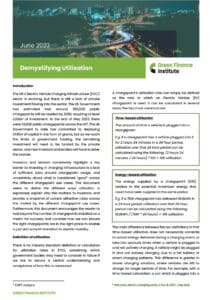Success in the Electric Vehicle Charging Infrastructure (EVCI) sector to date has been measured by the number of chargepoints being installed, rather than where they are and how they are used.
With transportation responsible for 24% of domestic greenhouse gas emissions, and road transport alone contributing 55% of this total, it is clear that to hit net zero, we need a system-wide shift in mobility patterns. This means changing the way that we think about charging infrastructure and measure the success of its installation.
Utilisation as a new measure of success for a profitable transition to net zero
Today, the EVCI sector does not focus on the metrics that ultimately determine financial returns: how the network is used. A higher number of chargepoints installed does not necessarily equal higher returns. Instead, we should focus on how and where energy is being supplied, as this drives revenue, and therefore potential profitability.
If the EV transition is to take place across the UK, we need charging infrastructure in the places where the demand doesn’t yet exist, but will in the run up to 2030 when the new ICE vehicle ban is in place.
Collaboration between the public and private sectors to reorientate the definition of success towards utilisation is pivotal to maximise investment in the EVCI sector. Doing so will enable and de-risk investment in less commercially viable areas to drive the transition and deliver an equitable and just path to net zero.
The need for data to change the narrative
Despite utilisation being the key metric for success to maximise both profits and progress, a lack of sufficient data around chargepoint usage is a barrier to mobilising investment into chargepoints in less commercially viable areas.
As an independent body, sitting between the public and private sector, a number of CPOs and local authorities have generously provided the GFI with supplementary data which shows an upward trajectory in utilisation in different business models across the country.
Forecast utilisation rates are a critical metric when measuring returns and payback period of an investment to accelerate the deployment of charging infrastructure in all areas. This data will be integral to provide confidence for lenders and investors to mobilise the private capital we need for the EV transition.
Mobilising the capital
With information on utilisation, the GFI has been rethinking the way we deliver finance to deploy charging infrastructure across the UK.
We need innovative financing to mobilise the capital required to deliver a just and equitable network across the UK. Utilisation Linked Loans (ULLs), working with the private and public sectors, is one of the solutions we are working on to do this.
ULLs have the potential to transform how charging infrastructure is financed. These loans could be used by chargepoint operators, local authorities or small businesses, and would be repayable based on utilisation. This structure can mitigate the risks around short-term utilisation rates to increase investor confidence, providing access to finance in areas where demand for charging infrastructure has yet to be established but will be required.
To invest the capital at the pace the science demands in road transport, we need to reimagine how we’re measuring success in the deployment of charging infrastructure, by focusing on utilisation.
